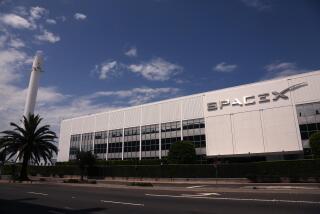Op-Ed: California’s economy may seem healthy. But just wait for the next recession

The California economy may seem healthy on the surface, with home prices soaring, Silicon Valley booming and the state government posting big multi-year state budget surpluses thanks to a massive surge in capital gains tax revenues and income tax revenues from tech stocks.
But that good news masks a dangerous period ahead.
In fact, California‚Äôs heavy dependency on tax payments from the rich and on the continued strength of the tech economy makes the state highly vulnerable in the event of a significant slowdown ‚ÄĒ or, worse yet, a full-bore global recession. According to Jim Doti of the A. Gary Anderson Center for Economic Forecasting at Chapman University, the probability of a recession starting late this year or next is very high.
Property prices are already beginning to drop in parts of the Los Angeles area. Similarly the IPO market, a major source of capital gains, is retrenching. Financial setbacks for the wealthy are problematic for the state because the top 1% of income-earning Californians pay 46.2% of all personal income taxes.
We’ve been here before. After the last recession ended in 2009, it took the state five years to get revenue from income taxes back up to pre-downturn levels. During those five years the state received about $50 billion less in revenue than if the recession had not occurred, and government was forced to cut programs by about $45 billion to compensate, according to the California Franchise Tax board.
Today, the state is even more reliant on tax revenues from its wealthy elites: Capital gains collections have increased roughly fivefold since 2010. Income taxes, mostly from the very wealthy, which barely constituted one-third of state revenues in 1980, now make up two-thirds.
A new recession, or even simply a slowdown, would place California in a very difficult position, particularly given that it continues to engage in what CalMatters columnist Dan Walters calls ‚Äúan expansionist binge‚ÄĚ of ever greater social spending and housing subsidies. Despite strong annual budgets, California suffers the highest debt of any state ‚ÄĒ $507 billion. It is projected that the cost of servicing the state‚Äôs debt in 2022 and 2023 will be approximately $8 billion annually and could grow even higher as interest rates rise.
California’s pension obligations to its employees are, by some measurements, the nation’s highest.
Much of the state‚Äôs vulnerability reflects changes in its economy. In previous recessions, California benefited from a more diverse economy, which included aerospace, agribusiness, energy and a broad manufacturing sector. This time, Gov. Gavin Newsom‚Äôs vainglorious assertion that the state is ‚Äúroaring back‚ÄĚ from the pandemic has been very narrowly focused. He‚Äôs largely referring to Silicon Valley.
Even before the pandemic, California was already severely underperforming rivals like Texas, Washington, Arizona and Utah in such areas as construction, manufacturing and professional and business services. Job growth in so-called innovation industries outside Silicon Valley and, to a lesser extent, San Diego has been negligible, including in the L.A. area, despite hiring by firms like Amazon and the buzz of ‚ÄúSilicon Beach.‚ÄĚ What job growth there has been is concentrated in low-end professions, as in the Inland Empire and Central Valley.
California now suffers the nation’s fourth-highest unemployment rate and has experienced one of the slowest job recoveries from the pandemic of any state. It has the nation’s highest cost-adjusted poverty rate and among the highest levels of income inequality.
Critically, California’s domination of the tech economy may be weakening. Meta, the Silicon Valley-based parent company of Facebook and Instagram, has reportedly leased 33 floors in downtown Austin, while Apple, based in Cupertino, continues to expand in the Texas suburbs. Texas is also where Tesla is building its new factory. Elon Musk’s plan to purchase Twitter means that firm may also end up moving there from California.
California likely will continue to lead in tech but in diminished form. The Comptia ‚ÄúCyberState‚ÄĚ report projects that California will not make the top 10 states for tech growth by 2030, a list dominated by places like Utah, Texas, Florida and North Carolina. In 2019 Texas actually passed California in creating new tech jobs.
Meanwhile, more tech workers will probably move out of the state as their employers agree, post-pandemic, to let them work from home indefinitely. They’ll seek cheaper, safer, less congested areas.
It‚Äôs worrisome, to be sure. Yet the current economic crisis also creates opportunities, if California is willing to seize them. For example, the current drive toward reshoring ‚ÄĒ bringing American companies‚Äô manufacturing and services back from overseas ‚ÄĒ has created enormous opportunities. Consider Intel‚Äôs decision to invest $20 billion in a massive new computer-chip-making facility outside Columbus, Ohio. (Computer chips are overwhelmingly made in East Asia.)
If California could adjust some of its policies that are deemed hostile or too costly by employers, the next big Intel plant, or something similar, could locate in, say, south Los Angeles, Fresno or Riverside, where there are underutilized, trainable workforces. Keeping production here would help maintain California’s tech economy and create opportunities for Californians other than the financial and engineering elites.
This is also a strategic issue. Firms that do not manufacture their own products often find that they lack the ability to innovate and compete. As two Harvard researchers have demonstrated, when production moves away, innovation often follows.
Energy and the environment sectors also could play to California’s advantage. The state’s leadership, for example, in electric car design could be leveraged to expand auto manufacturing in the state. Right now, most battery production takes places in Nevada, the Midwest and the South.
The Russian crisis and ongoing economic competition with China create expanded opportunities for California to tap its vast store of natural resources, including natural gas and food production. As long as we are still using fossil fuels, it would make economic sense to tap energy here, creating high wage jobs ‚ÄĒ rather than import it, at great cost, from Russia or the Persian Gulf. (It would also be less harmful to the environment to have fossil fuels extracted and refined where environmental standards are higher.)
The war in Ukraine is also a reminder that California needs to reinvigorate its military industries, which still generate some $40 billion in annual contracts.
And while we already have a significant space industry employing approximately 24,000 people, it shows signs of moving out of state. We must not abandon what is likely to be a critical industry of the future.
California can survive, and even thrive, amidst a recession. But only if it develops a strategy that doesn‚Äôt depend on a few companies and the ultra-rich. The state‚Äôs current approach is fundamentally unsustainable, but its potential to succeed ‚ÄĒ and restore California‚Äôs dream ‚ÄĒ has never been greater.
Joel Kotkin is the presidential fellow in urban futures at Chapman University. Marshall Toplansky is a clinical assistant professor of management science at the Argyros School of Business and Economics at Chapman University.
More to Read
A cure for the common opinion
Get thought-provoking perspectives with our weekly newsletter.
You may occasionally receive promotional content from the Los Angeles Times.










